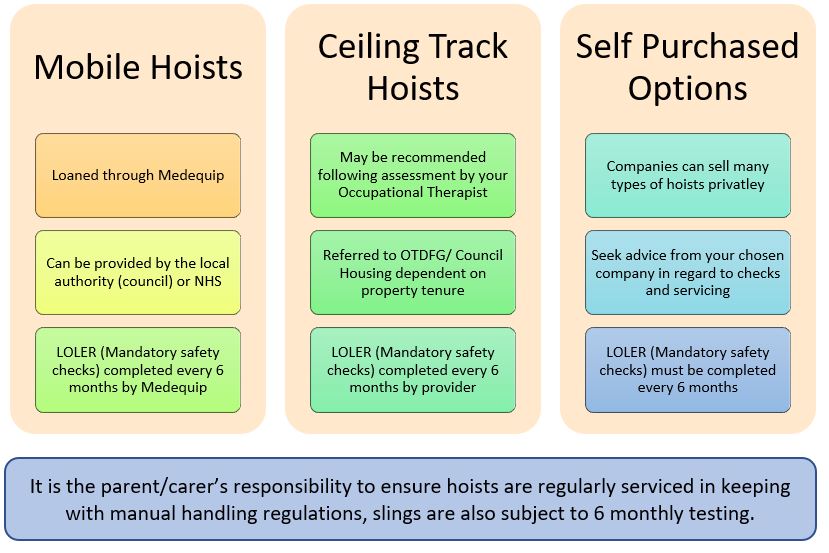Children and Young People's Occupational Therapy Service
Moving and Handling
Hoist Information
Hoisting may seem daunting at first, it comes with new practices, techniques and the equipment. You may have been recommended hoisting by your Occupational Therapist for a variety of reasons, it is never the first port of call and understanding your recommendations is extremely important. Your Occupational Therapist will discuss options with you and may trial different bits of equipment or techniques as part of the assessment process.
What is a hoist?
A hoist is a piece of equipment designed to minimise risk in lifting or carrying another person. It could be considered similar to a small crane which completes the lifting and lowering actions for you.
What are transfers?
Professionals and other persons visiting your home may refer to ‘transfers’, this is simply the word used to explain moving from one space to another such as lifting onto the bed. We may say ‘chair transfer’ instead of ‘getting on and off of the chair’’.
Why might a hoist be recommended for to support my child?
Many factors are considered in looking for appropriate transfer solutions. The most common reason for hoisting is for safety purposes, for the safety or the child or young person and the safety of those supporting them. If your child also receives external support such as that from carers, visiting professionals or require support within their educational environment, it is important that their transfers are considered, as external support must operate within the law.

Types of Hoists
Hoists come in many shapes and sizes, which means that there can often be lots of hoisting solutions available. Hoists which are recommended by professionals such as your Occupational Therapist may be loaned or provided through a grant, or alternatively you may seek self-purchase options.

Mobile Hoists
Mobile Hoists are freestanding pieces of equipment which have wheels that enable you to move around your home. Some mobile hoists have folding functions and different capabilities, with new innovations across the world every day.
Mobile hoists are generally loaned by the local authority (council) or sometimes the NHS, loans are carried out by our partner Medequip who look after delivery, servicing, repairs and collection. You can find a contact number for Medequip on their sticker located on the column of your hoist.
Ceiling Track Hoists
Ceiling track hoists, often referred to CTH’s, are hoists which are mounted to a ceiling to maximise an environments space and usage. These hoists can be made to fit or accommodate lots of different situations and needs however may not be suitable for all structures (such as false or suspended ceilings).
Ceiling Track hoists cannot be moved and operate in a set space, they generally have a ‘dock’ for charging purposes.
Ceiling track hoists, where recommended, can be provided through Disabled Facilities Grants.
Other Hoists
Gantry Hoists – Hoists which are similar to ceiling tracks hoists in their function however are temporary fixtures. These hoists can sometimes be a solution for certain environments however can take time to set up and allow point A to point B pickup only in most cases.
Public Hoists – Some public spaces such as hospitals, airports and supermarkets may have bathrooms with hoists in place to support using the toilet or changing table. When using these hoists, pay attention to all safety information provided, complete equipment checks as you usually would unless otherwise stated or if in any doubt ask a member of staff.
Sling Application
Please be aware that these are general guidance points, your Occupational Therapist may have shown you techniques and tips specific to your child. The easiest way to apply a sling may be in the lie flat position.
Position
- If possible raise the bed to waist height to minimise bending and reaching.
- With your child lying on their back, supporting them at the hip and shoulder, roll them onto their side.
- If your child is unable to maintain a side lying position, you may use a pillow or wedge to support their position.
- Always ensure your child’s mouth and nose are visible and uncovered.
Sling
- Check that the sling’s label has not faded, there are no frays holes or tears on the sling and that all loops are in tact.
- Fold the sling in half with the label on the outside, labels should always be visible and should not touch the skin. The sling should cover from the buttocks to the head (dependent on sling type).
- Tuck the folded seam of the sling under your child, you may roll the folded half if this is easier (it may depend on the size of your child)
- Carefully roll your child onto their back, the sling should naturally lay flat, but if needed, gently manoeuvre elements into place – be careful not to tug or use harsh movements that may be abrasive to the skin.
- Ensure where possible that any kinks or bunched up fabric is minimised and that the slings surface is smoothed out as much as possible.
Lifting and Lowering
- Once your child is central in the sling and you have completed equipment checks of the hoist, you can proceed to attaching the loops.
- Always ensure the loops are untangled, clear for you to see and secure when attached.
- Prior to completing a full lift, always complete a ‘test tug’ – raise the hoists boom until the the loops of the sling begin to become taught, at this point pause lifting to check that everything is secure and that your child is comfortable and that there is no pinching of the skin or tangles in the sling.
- If the position is incorrect or the child is in discomfort, never try to adjust the sling whilst lifting. You must lower and begin again.
- When attaching the loops, your OT may have discussed your options specific to your child, rule of thumb is “short shoulders and longer legs” however, this is always dependent on comfort and desired position.
Contact
Duty and Advice Line – 0121 303 3865
Email – cypot@birmingham.gov.uk
Sling Safety
If you have any questions or worries about your slings, please contact the service as soon as possible.
- Do not use a sling that has visible damage such as burns, rips, tears or fraying.
- Do not use the sling if it is causing injury or significant discomfort.
- Do not use a sling that is too small or does not fit securely.
- Do not boil, wash or use strong detergents/bleach to clean slings.
- Do not ignore manufacturer guidance.
- Do not leave the child unattended whilst slings are in use.
- Your child’s sling should have a safety check every 6 months, this is called a Loler check and is usually completed alongside the hoists safety check.

